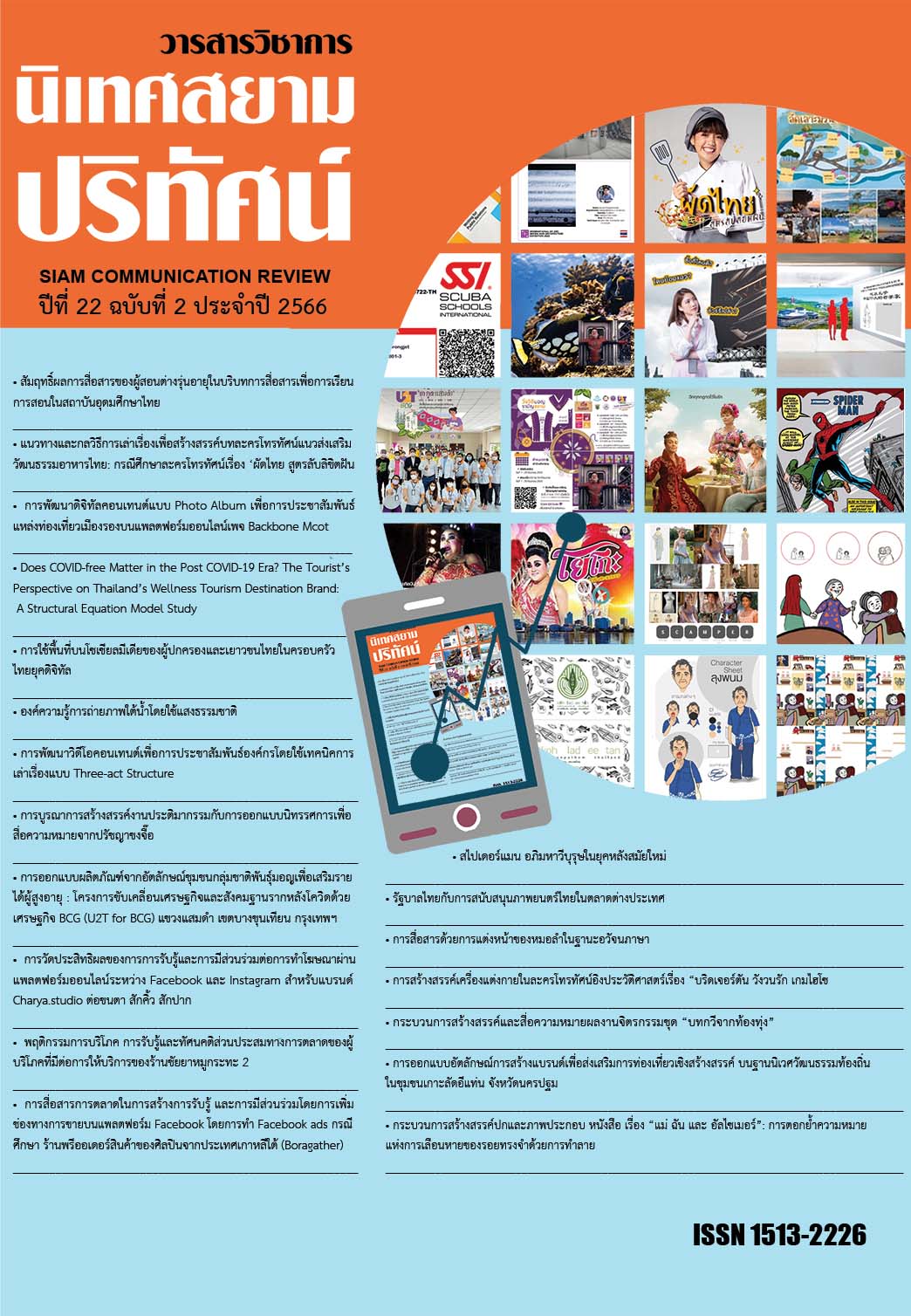Nonverbal Communication through Makeup of Thai Northeastern Folksingers (Morlum)
Main Article Content
Abstract
This article aimed to analyze characteristics and dynamics of nonverbal communication identities through the makeup of Thai northeastern folksingers. The study revealed that folksingers' makeups were sign language and concluded as nonverbal communication in three aspects: gestures, artifacts (items and images), and paralinguistics (such as volume or tone of voice). Furthermore, text was formed in situations during folk singing performances by self-expression through folksinger makeup. The application of codes in makeup resulted in a dynamic of identities as a level of meta-communication, resulting in different makeup of folksingers. Thus, the alteration of forms and characteristics altered human perceptions in numerous outcomes, resulting in enjoyment and enthusiasm known as the moment of happiness between senders and receivers.
Article Details

This work is licensed under a Creative Commons Attribution-NonCommercial-NoDerivatives 4.0 International License.
References
กฤษณ์ ทองเลิศ. (2535). ลักษณะของการสร้างฝันจินตนาการทางเพศในสื่อมวลชนไทย. วิทยานิพนธ์ปริญญานิเทศศาสตรมหาบัณฑิต ภาควิชาการสื่อสารมวลชน คณะนิเทศศาสตร์ จุฬาลงกรณ์มหาวิทยาลัย.
บุษกร บิณฑสันต์ และขำคม พรประสิทธิ์. (2553). หมอลำ. กรุงเทพฯ: จุฬาลงกรณ์มหาวิทยาลัย.
ปัณณทัต ลำเฟือย และอนุกูล โรจนสุขสมบูรณ์. (2564). การแสดงหมอลำคณะเสียงอิสาน. วารสารสังคมศาสตร์เพื่อการพัฒนาท้องถิ่น มหาวิทยาลัยราชภัฏมหาสารคาม5(3), 76-83.
ปอรรัชม์ ยอดเณร. (2561). การพัฒนาอวัจนภาษาในการสื่อสารผ่านกระบวนการสื่อสารการแสดง. วารสารการประชาสัมพันธ์และการโฆษณาฉบับพิเศษ ฉบับพิเศษเรื่อง “ทัศนคติ ความพึงพอใจ กับการสื่อสารผ่านสื่อที่แตกต่าง”, 11(special edition2018): 15-25.
พระครูจิรธรรมธัช. (2553). การประยุกต์หลักพุทธธรรมที่ใช้ในการบริหารจัดการวงดนตรี หมอลําคณะเสียงอิสาน นกน้อยอุไรพร. วิทยานิพนธ์รปริญญาพุทธศาสตรมหาบัณฑิต สาขาวิชาพระพุทธศาสนา บัณฑิตวิทยาลัย มหาวิทยาลัยจุฬาลงกรณราชวิทยาลัย.
มนูศักดิ์ เรืองเดช. (2552). การแสดงหมอลำ กรณีศึกษาชุมชนหมอลำข้างวัดมัชฌิมาวาส กับบริบททางสังคม จังหวัดอุดรธานี. วิทยานิพนธ์ปริญญาศิลปศาสตรมหาบัณฑิต สาขาวิชานาฏศิลป์ไทย คณะศิลปกรรมศาสตร์ จุฬาลงกรณ์มหาวิทยาลัย.
รังสรรค์ ศิริชู. (2530). เรียนรู้เทคนิคและศิลปะการ ถ่ายภาพ. กรุงเทพฯ: บางกอกสาส์น.
ราชบัณฑิตยสถาน. (2525). พจนานุกรมฉบับราชบัณฑิตยสถาน พ.ศ.2525. กรุงเทพฯ: อักษรเจริญทัศน์.
ศิริชัย ทัพขวา. (2560). การพัฒนารูปแบบการแสดงหมอลําหมู่เชิงธุรกิจ. วิทยานิพนธ์ปริญญาปรัชญาดุษฎีบัณฑิต สาขาวัฒนธรรมศาสตร์ มหาวิทยาลัยมหาสารคาม.
ศิริชัย ศิริกายะ. (2558). แบบจำลองการสื่อสารในยุคดิจิทัล. วารสารนิเทศสยามปริทัศน์ 13(15), 8-13.
สุริยพงษ์ บุญโกมล (2558). วิธีการขับร้องหมอลำกลอน ของหมอลำ ป.ฉลาดน้อย. วิทยานิพนธ์ปริญญาศิลปศาสตรมหาบัณฑิต สาขาวิชาดุริยางค์ไทย คณะศิลปกรรมศาสตร์ จุฬาลงกรณ์มหาวิทยาลัย.
ภาษาอังกฤษ
Genette, G .(1997). Paratexts : thresholds of interpretation. (Translated by Channa Newman and Claude Doubinsky). Lincoln: University of Nebraska Press.
Hirschman, A. (1970). Exit, Voice, and Loyalty: Responses to Decline in Fims, Organizations, and States. Cambridge, MA: Harvard University Press.
Jenkins, H. (1992). Sexual Poachers. New York and London : Routledge


